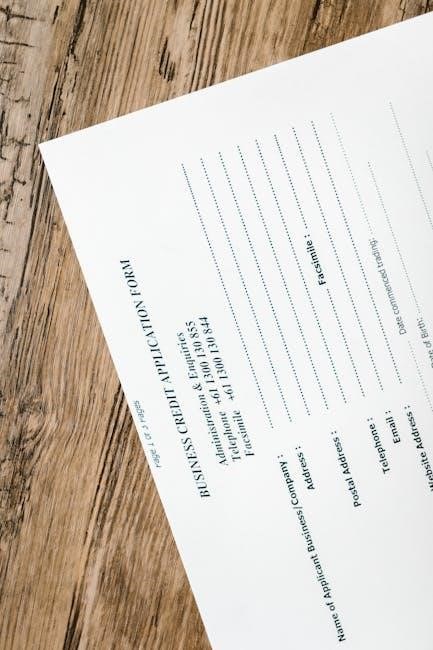Form 4136 allows taxpayers to claim a credit for federal taxes paid on fuels used for nontaxable purposes, such as agriculture or off-highway business use. It also covers alternative fuel and blending credits, providing refunds for eligible fuel uses. Recent updates for tax year 2024 ensure compliance with current IRS regulations.

1.1 Overview of Form 4136
Form 4136 is an IRS form used to claim a credit for federal taxes paid on fuels used for certain nontaxable purposes. It applies to fuels purchased for activities like agriculture, off-highway business use, or other exempt purposes. The form also covers credits for alternative fuels and blending diesel-water fuel emulsions. Taxpayers can claim refunds for eligible fuel uses, ensuring they aren’t double-taxed. Recent updates for tax year 2024 reflect current IRS guidelines, ensuring accurate filing. This form is essential for individuals and businesses seeking to recover federal fuel taxes paid on non-taxable fuel uses, providing a clear process to calculate and claim eligible credits.
1.2 Purpose of the Form
The primary purpose of Form 4136 is to allow taxpayers to claim a credit for federal excise taxes paid on fuels used for nontaxable purposes. This includes fuels used in activities such as agriculture, off-highway business use, or other exempt purposes. The form also enables claims for alternative fuel credits and blending credits, such as those for diesel-water fuel emulsions. By filing this form, taxpayers can recover federal taxes paid on fuels that are not subject to excise tax, ensuring they are not double-taxed. It is essential for individuals and businesses to accurately report their fuel usage and calculate the eligible credit to comply with IRS regulations and maximize their refund.
Eligibility Criteria for Claiming the Credit

Eligibility for the credit requires taxpayers to use fuel for nontaxable purposes, such as agriculture or off-highway business activities, and meet specific IRS guidelines for qualification.
2.1 Types of Taxpayers Eligible for the Credit
Individuals, businesses, and tax-exempt organizations may qualify for the credit if they use fuel for nontaxable purposes. Eligible taxpayers include those engaged in agriculture, construction, or off-highway business activities. Additionally, entities using fuel for non-highway purposes, such as boats or generators, may also claim the credit. The IRS specifies that only fuel used for these qualified purposes is eligible, ensuring the credit is targeted toward specific industries and uses. Proper documentation and adherence to IRS guidelines are essential to validate eligibility and avoid discrepancies during filing.
2.2 Nontaxable Uses of Fuel That Qualify for the Credit
Nontaxable uses of fuel eligible for the credit include off-highway business activities, such as farming, construction, and industrial operations. Fuel used for generating electricity or powering stationary equipment also qualifies. Additionally, fuel used in boats, generators, and other non-vehicular applications may be eligible. The IRS specifies that fuel used for personal commuting or highway use does not qualify. Proper documentation of fuel usage is essential to ensure compliance and validate the claim. Taxpayers must maintain records to demonstrate that the fuel was used for qualified purposes, as misclassification can lead to disallowance of the credit.

Calculating the Credit for Federal Tax Paid on Fuels
Calculating the credit involves multiplying the gallons of fuel by the applicable tax rate, ensuring accurate records and compliance with IRS guidelines for eligibility.
3.1 How to Calculate the Credit
To calculate the credit, multiply the number of gallons used for nontaxable purposes by the applicable federal tax rate. Ensure records of fuel purchases and usage are maintained. Determine the eligible fuel types and their respective tax rates. Apply the credit calculation to each type of fuel separately. Add the credits for all eligible fuels to get the total credit amount. Consider any limitations or phase-outs based on income or usage. For alternative fuels, use the specific rates provided by the IRS. Keep accurate documentation to support the calculation. Refer to the IRS instructions for Form 4136 for the most current tax rates and exclusions. This ensures compliance and accuracy in claiming the credit.
3.2 Maximum Credit Amounts and Limitations
The credit is subject to maximum amounts based on fuel type and usage. For nontaxable uses, the credit per gallon is capped at the federal tax rate. Total credits are limited annually, and phase-outs apply for high-income taxpayers. Credits for alternative fuels and blending are also capped separately. The IRS sets specific limits for each fuel type, ensuring fairness and preventing over-claiming. Unused credits cannot be carried forward to future tax years. Documentation must support the claimed amounts to avoid reductions. Stay updated with IRS guidelines for the latest limits and restrictions. Proper calculation and adherence to these rules are essential to maximize the credit without exceeding allowable thresholds.
3.3 Alternative Fuel Credit and Blending Credit
The Alternative Fuel Credit and Blending Credit are specific components of Form 4136, designed to incentivize the use of environmentally friendly fuels. The Alternative Fuel Credit applies to fuels like biodiesel, renewable diesel, and certain alternative fuels not subject to excise tax. The Blending Credit is available for mixing diesel with water and a stabilizing additive to create a fuel emulsion. Both credits have specific rates per gallon and are subject to annual caps. Eligible taxpayers must document the production or usage of these fuels to claim the credits. The IRS sets maximum amounts for each type of credit to ensure compliance with federal regulations; Proper calculation and documentation are essential to avoid discrepancies and ensure full eligibility for these credits.

Required Documentation for Form 4136
Form 4136 requires detailed records, including fuel purchase receipts, usage logs, and certificates for alternative fuels. Accurate documentation ensures compliance and validates credit claims.
4.1 Records Needed to Support the Credit Claim
To claim the credit using Form 4136, taxpayers must maintain detailed records that substantiate their fuel purchases and usage. This includes receipts for fuel purchases, logs documenting the amount of fuel used for nontaxable purposes, and records showing the type of fuel used. For alternative fuels, certificates from suppliers or producers may be required to verify eligibility. Additionally, businesses must keep records of how fuel was used, such as for off-highway vehicles or equipment. These documents are essential to support the credit claim and must be retained in case of an IRS audit. Accurate and complete records ensure compliance with IRS requirements.
4.2 Importance of Accurate Documentation
Accurate documentation is crucial when claiming the credit using Form 4136, as it ensures compliance with IRS requirements and avoids potential audits or delays. Incomplete or incorrect records can lead to disqualification of the credit or additional scrutiny from the IRS. Taxpayers must ensure all fuel purchases, usage, and nontaxable purposes are thoroughly documented. This includes maintaining receipts, logs, and certificates for alternative fuels. Precise records demonstrate the legitimacy of the claim and help taxpayers avoid penalties. The IRS may request additional proof, so organizing and preserving all relevant documents is essential. Accurate documentation not only streamlines the filing process but also protects taxpayers from potential disputes or adjustments to their claims.

Filing Instructions for Form 4136
File Form 4136 with your annual tax return by the deadline. Submit to the IRS address provided in the instructions. Ensure all details are accurate to prevent processing delays.
5.1 When to File Form 4136
Form 4136 must be filed by the standard tax filing deadline, typically April 15th for individual taxpayers. For businesses, the deadline aligns with the business tax return due date. If you file for an extension, the form must be submitted by the extended deadline, usually October 15th for individuals and October 15th for businesses. Fiscal year taxpayers should adjust the deadline according to their tax year. If the deadline falls on a weekend or federal holiday, the form is due the next business day. Ensure Form 4136 is submitted with your main tax return to avoid processing delays. Accurate and timely filing is crucial for proper credit consideration.
5.2 Where to File the Form
Form 4136 must be filed with the IRS, either electronically or by mail. For individual taxpayers, the form should be attached to your Form 1040 and mailed to the IRS address listed in the instructions for Form 1040. Businesses should attach Form 4136 to their business tax return and mail it to the address specified for their type of return. E-filing is also an option and is generally faster and more convenient. Ensure the form is submitted to the correct address to avoid delays in processing. Always verify the most current IRS instructions for any updates on filing locations or requirements.
5.3 Filing as an Individual vs. a Business
When filing Form 4136, the process differs slightly for individuals and businesses. Individuals must attach the completed Form 4136 to their personal tax return, Form 1040, and report the credit in the appropriate section. Businesses, however, must attach Form 4136 to their business tax return, such as Form 1120 for corporations or Form 1065 for partnerships. The credit is claimed on the business return, reflecting the fuel taxes paid for business-related activities. Both individuals and businesses must ensure all required documentation is included to support the credit claim. The filing process ensures the IRS can accurately process the credit for federal taxes paid on fuels, regardless of the taxpayer type.

Claiming the Credit on Your Tax Return
Claim the credit by attaching Form 4136 to your main tax return, ensuring accurate reporting of eligible fuel taxes paid for nontaxable purposes, whether personal or business-related.
6.1 How to Report the Credit on Your Tax Return
To report the credit, attach Form 4136 to your main tax return. Enter the total credit from Part II of Form 4136 on Schedule 3 (Form 1040), Line 54. Ensure all calculations are accurate and supported by proper documentation. For businesses, the credit is claimed on the appropriate business return, such as Form 1120 or Schedule C. Accurately report the credit to avoid delays or discrepancies in processing. Keep detailed records of fuel purchases and usage to substantiate your claim. Consulting a tax professional can help ensure compliance with IRS requirements and maximize your eligible credit amount.

6.2 Claiming the Credit for Multiple Activities
If you use fuel for multiple nontaxable purposes or operate multiple businesses, you must calculate the credit separately for each activity. Use Form 4136 to report each type of fuel use, ensuring accurate allocation of taxes paid. For example, separate calculations are required for agricultural use and off-highway business use. Maintain detailed records for each activity to support your claims. Combine all eligible credits on a single Form 4136 and attach it to your main tax return. This ensures proper reporting and avoids potential discrepancies. Proper documentation is essential to validate multiple claims and prevent audit issues. Always verify IRS guidelines for specific requirements when claiming credits for diverse activities.

Special Considerations and Exceptions
Certain fuel types qualify for the credit, and state or local taxes may affect claims. Exceptions apply based on usage and industry-specific rules.

7.1 Fuel Types Eligible for the Credit
Form 4136 applies to specific fuel types, including gasoline, diesel, and alternative fuels like biodiesel or diesel-water emulsions. Eligible fuels must be used for nontaxable purposes, such as off-road or agricultural activities. The credit also extends to certain blended fuels, provided they meet IRS specifications. Taxpayers must ensure the fuel type aligns with IRS guidelines to qualify for the credit. Proper documentation of fuel usage and type is essential to avoid discrepancies. Additionally, the IRS may update eligible fuel types periodically, so staying informed about recent changes is crucial for accurate claims.
7.2 State and Local Tax Implications
While Form 4136 focuses on federal tax credits, state and local tax implications may vary. Some states offer additional credits or exemptions for fuel taxes, while others may have specific rules. Taxpayers must comply with both federal and state requirements to avoid discrepancies. State taxes on fuel could affect the overall refund amount, so understanding local regulations is essential. Additionally, some states may require separate documentation for state-specific fuel tax credits. It’s important to consult state tax authorities to ensure compliance and maximize eligible credits. Proper documentation and awareness of state laws can help prevent issues during tax filing.
Recent Updates to Form 4136
Form 4136 has been updated for tax year 2024, with revised instructions and guidelines to reflect current IRS regulations. These changes ensure compliance and accuracy in claiming fuel tax credits.
8.1 Changes for Tax Year 2024
For tax year 2024, Form 4136 has undergone revisions to align with updated IRS regulations. Key changes include adjustments to eligible fuel types, updated calculation methods for credits, and expanded documentation requirements. The IRS has also introduced new guidelines for claiming alternative fuel and blending credits, ensuring compliance with current environmental and tax policies. These updates aim to streamline the filing process and reduce errors. Taxpayers are advised to review the revised instructions carefully to ensure accurate credit claims. The changes took effect on January 1, 2024, and apply to all fuel purchases made during the tax year. Proper documentation remains critical to avoid delays in processing refunds.
8.2 IRS Guidance and Notifications
The IRS regularly provides updated guidance and notifications for Form 4136 to ensure taxpayers are informed about changes and requirements. For tax year 2024, the IRS has released revised instructions and updated forms, including Schedule SE, to reflect current regulations. Taxpayers are encouraged to review these updates to ensure compliance. The IRS also offers webinars, publications, and online resources to help navigate the filing process. Additionally, the IRS notifies taxpayers about deadlines, documentation requirements, and any new provisions affecting fuel tax credits. Staying informed through official IRS channels is essential for accurate and timely filing of Form 4136. Subscribe to IRS updates or consult their official website for the latest information.
Future Changes and Expected Updates
The IRS anticipates modifications to Form 4136 in response to legislative changes and taxpayer feedback, ensuring alignment with environmental policies and sustainable energy incentives.
9.1 Anticipated Modifications for Upcoming Tax Years
The IRS plans to update Form 4136 to reflect evolving energy policies and environmental goals. Future modifications may include expanded eligibility for alternative fuels, increased credit amounts for sustainable energy uses, and streamlined reporting requirements. These changes aim to align the form with federal initiatives promoting cleaner energy and reducing carbon emissions. Taxpayers can expect clearer guidelines on eligible fuel types and usage categories. Additionally, the IRS may introduce new credits for emerging fuel technologies, ensuring the form remains relevant in a rapidly changing energy landscape. These updates will likely be implemented in response to legislative changes and stakeholder feedback, ensuring the credit system remains effective and equitable.
9.2 Impact of Legislative Changes
Legislative changes, such as updates to energy policies or tax reforms, can significantly impact Form 4136. New laws may expand or limit eligibility for fuel tax credits, affecting both individuals and businesses. For instance, changes in environmental regulations could introduce credits for new types of alternative fuels or increase existing credit amounts. Additionally, modifications to tax rates or refundable credit provisions may alter the financial benefits of claiming the credit. The IRS will implement these changes through updated forms, instructions, and guidance, ensuring compliance with new legal requirements. Taxpayers must stay informed about legislative updates to accurately claim their credits and adhere to evolving rules. These changes often aim to align the tax code with broader economic and environmental goals, making it essential for filers to adapt accordingly.
Form 4136 is a valuable tool for taxpayers to recover federal taxes paid on fuels used for nontaxable purposes, offering credits for alternative fuels and blending. By understanding eligibility criteria, maintaining proper documentation, and staying updated on legislative changes, filers can maximize their benefits. Recent updates for tax year 2024 ensure compliance with current IRS regulations, while future changes may expand credit opportunities. Taxpayers should consult IRS guidance and seek professional advice to navigate the process effectively. Accurate filing and awareness of program modifications are key to ensuring compliance and optimizing refunds. Form 4136 remains a critical component of tax strategies for individuals and businesses utilizing fuel in nontaxable contexts.

